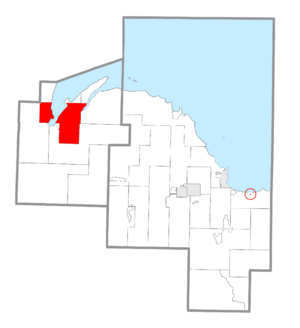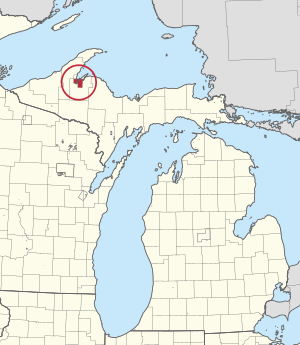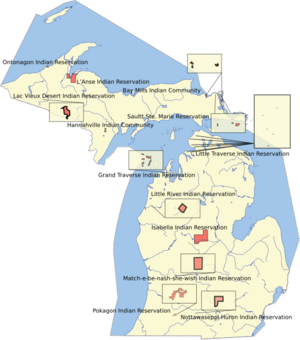L'Anse Indian Reservation facts for kids
Quick facts for kids
L'Anse Indian Reservation
Gakiiwe’onaning
Keweenaw Bay Indian Community
|
|
|---|---|

Locations within Baraga County (left) and Marquette County (right)
|
|

Location within the State of Michigan
|
|
| Country | United States |
| State | Michigan |
| Counties | Baraga and Marquette |
| Established | 1854 |
| Re-establishment | 1934 (tribal government) |
| Area | |
| • Total | 110.06 sq mi (285.1 km2) |
| • Land | 91.98 sq mi (238.2 km2) |
| • Water | 18.08 sq mi (46.8 km2) 16.4% |
| (includes off-reservation trust land) | |
| Population
(2020)
|
|
| • Total | 3,396 |
| • Density | 36.9/sq mi (14.3/km2) |
| (includes off-reservation trust land) | |
| Time zone | UTC-5 (Eastern (EST)) |
| • Summer (DST) | UTC-4 (EDT) |
| Website | http://www.kbic-nsn.gov/ |
| Total population | |
|---|---|
| Enrolled members: 3,159 (1999) | |
| Regions with significant populations | |
| Languages | |
| English, Ojibwe | |
| Religion | |
| Christianity | |
| Related ethnic groups | |
| Odawa, Potawatomie |
The L'Anse Indian Reservation is the home of the federally recognized Keweenaw Bay Indian Community. This community is part of the historic Lake Superior Band of Chippewa Indians. The reservation is mostly located in two separate parts around the Keweenaw Bay in Baraga County, in the Upper Peninsula of Michigan. The Keweenaw Bay Community also manages another area called the Ontonagon Indian Reservation.
In 2020, about 3,396 people lived on the L'Anse reservation. It covers about 91.98 square miles of land. Most of the village of Baraga and part of the village of L'Anse are on reservation land.
Contents
History of the L'Anse Reservation
This area was traditionally the land of the L'Anse Band of the Lake Superior Band of Chippewa Indians. This was a large group of related bands living around the southern part of Lake Superior.
Early European Contact
The European-American town of L'Anse grew from a French fur trading post. This post was set up long ago where an Ojibwa village already existed. After the British took control of this area from the French, the town continued to grow. Later, after the War of 1812, this land became part of the United States.
Land Treaties and the Reservation
As more European-American settlers moved into Michigan in the early 1800s, the United States wanted the Ojibwa to give up their lands. This would allow for new settlements and development. The Treaty of 1842 was a huge agreement where the Chippewa gave up a lot of land to the U.S. government. However, this treaty also said that the Chippewa could still fish, hunt, and gather on these lands.
The L'Anse Reservation is the oldest and largest reservation in Michigan. It was created under the Chippewa Treaty of 1854. The United States Supreme Court has said that this treaty created lasting homelands for the Chippewa (Ojibwa Anishnaabeg) bands who signed it.
In 2024, the Keweenaw Bay Indian Community received 760 acres of forestland. This land was transferred from The Nature Conservancy and is located within the reservation's original 1842 boundary.
Geography of the Reservation
The reservation includes land on both sides of the Keweenaw Bay in Baraga County, Michigan. The entire reservation covers almost one-third of Baraga County. The biggest part is on the east side of Keweenaw Bay. A smaller part is on the west side. There is also a very small part of the reservation in Marquette County.
Land Area and Ownership
The L'Anse reservation and its related trust lands cover about 110.06 square miles. Of this, about 91.98 square miles is land and 18.08 square miles is water.
Because of a law called the Dawes Act from 1886, only about 36% of the land inside the reservation is owned by the Keweenaw Bay Indian Community. The rest of the land is owned by individuals (both tribal members and others), businesses, and local governments.
People of the L'Anse Reservation
According to the 2020 census, the L'Anse Reservation had a population of 3,396 people. The population density was about 36.9 people per square mile.
The people living on the reservation were 58.6% White, 29.3% Native American, and 0.1% Black or African American. About 0.6% were from other races, and 11.3% were from two or more races. About 1.1% of the population was Hispanic or Latino.
Economy and Community Life
The Keweenaw Indian Community works to support its people and protect the environment.
Tribal Businesses
The tribe runs a fish hatchery at Pequamining Bay on Lake Superior. This hatchery helps improve and protect the water quality in the lake. It also supports fish and other natural populations.
The tribe also operates two casinos. One is called Ojibwa I and is on reservation land in Baraga County. The other is Ojibwa II in Marquette County.
Communities on the Reservation


